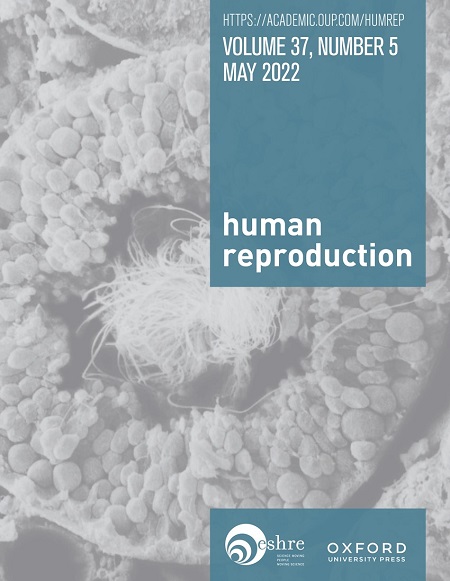ART受孕后儿童癌症风险的性别差异:一项基于登记的研究
IF 6
1区 医学
Q1 OBSTETRICS & GYNECOLOGY
引用次数: 0
摘要
研究问题:接受抗逆转录病毒治疗后儿童患癌症的风险是否因性别而异?在这项基于登记的研究中,一些儿童癌症在使用某些ART方式受孕的儿童中显示出性别和年龄特异性的正相关,这在总体联合分析中并不明显。在先前的研究中,ART与儿童癌症风险之间的关系显示出不同的结果。目前还缺乏关于ART受孕后儿童癌症风险是否存在性别差异的研究。这项基于登记的队列研究纳入了1984年至2022年在挪威出生的所有儿童(n = 2 255 025),随访至2023年12月31日。参与者/材料、环境、方法通过挪威医学出生登记处确定儿童,并提取有关他们是否通过ART(定义为IVF/ICSI)受孕的信息。在纳入研究的255025名儿童中,53694名是通过人工受精受孕的。出生记录与挪威癌症登记处相关联。根据国际儿童癌症分类第三版(ICCC-3),儿童癌症被定义为18岁之前的癌症诊断。Cox回归模型用于估计接受ART治疗的儿童与未接受ART治疗的儿童的年龄和性别特异性癌症风险。在所有儿童中,0.25%在18岁之前被诊断出癌症。通过ART (IVF/ICSI)受孕的儿童的累积癌症发病率高于未通过ART受孕的儿童(21.5 vs 17.5 / 100000人-年,P = 0.04),特别是通过ICSI或冷冻胚胎移植受孕的男孩。当综合所有年龄组、性别和所有癌症类型时,几乎没有证据表明ART会增加癌症风险(校正风险比(aHR) 1.13, 95% CI 0.94-1.36)。然而,当按年龄和性别分层时,发现了差异。从5-9岁开始,接受art治疗的儿童患癌症的总体风险较高(aHR 1.53, 95% CI 1.06-2.20),其中男孩的aHR 1.73, 95% CI 1.09-2.74略高于女孩(aHR 1.28, 95% CI 0.70-2.33)。直到5岁或10岁以后,风险都没有增加。在综合分析中,ICSI后没有增加总体风险。当按性别分层时,ICSI后男孩的风险更高(aHR 1.69, 95% CI 1.18-2.42),但女孩没有(aHR 0.65, 95% CI 0.37-1.16)。冷冻保存后的综合风险(aHR 1.42, 95% CI 0.95-2.13)是由男孩较高的风险(aHR 1.79, 95% CI 1.09-2.94)驱动的,而在女孩中没有发现关联的证据(aHR 1.01, 95% CI 0.50-2.03)。无论是男孩还是女孩,体外受精或新鲜移植后的风险都没有增加。儿童癌症是一种罕见的结果,一些癌症亚型的分析可能不够有力。这项基于登记的大型研究的结果表明,解决ART受孕后儿童癌症风险的年龄和性别特异性差异揭示了某些群体的风险增加。我们的发现需要进一步研究,考虑与ART和不同儿童癌症相关的潜在性别特异性机制。研究经费/竞争利益(S)这项工作由:挪威研究理事会通过其卓越中心资助计划(项目编号262700)资助;挪威癌症协会(项目编号244291);以及挪威公共卫生研究所。资助机构在概念化、设计、数据收集、分析、决定发表或准备手稿方面没有任何作用。作者声明没有利益冲突。试验注册号n / a。本文章由计算机程序翻译,如有差异,请以英文原文为准。
Sex differences in childhood cancer risk following ART conception: a registry-based study
STUDY QUESTION Does the risk of childhood cancer following ARTs vary by sex? SUMMARY ANSWER In this registry-based study, some childhood cancers showed positive sex- and age-specific associations in children conceived using certain ART modalities, which were not evident in overall combined analyses. WHAT IS KNOWN ALREADY The relationship between ART and risk of childhood cancer has shown diverse outcomes in prior research. Studies examining whether there are sex differences in childhood cancer risk after ART conception are lacking. STUDY DESIGN, SIZE, DURATION This registry-based cohort study included all children born in Norway between 1984 and 2022 (n = 2 255 025), followed until 31 December 2023. PARTICIPANTS/MATERIALS, SETTING, METHODS Children were identified via the Medical Birth Registry of Norway, and information was extracted on whether they were conceived via ART (defined as IVF/ICSI). Of the 2 255 025 children included in the study, 53 694 were ART-conceived. Birth records were linked to the Cancer Registry of Norway. Childhood cancer was defined as a cancer diagnosis according to the International Classification of Childhood Cancer Third Edition (ICCC-3) before the age of 18 years. Cox regression models were used to estimate the age- and sex-specific risk of cancer for ART-conceived children compared to children not conceived via ART. MAIN RESULTS AND THE ROLE OF CHANCE Among all children, 0.25% had a cancer diagnosis before the age of 18 years. The cumulative incidence of cancer was higher in children conceived by ART (IVF/ICSI) than in those not conceived via ART (21.5 vs 17.5 per 100 000 person-years, P = 0.04), and especially higher in boys conceived with ICSI or after cryopreserved embryo transfer. When combining all age groups, both sexes and all cancer types, there was little evidence of increased cancer risk with ART (adjusted hazard ratio (aHR) 1.13, 95% CI 0.94–1.36). However, differences were found when stratifying by age and sex. From age 5–9 years, ART-conceived children had a higher overall risk of cancer (aHR 1.53, 95% CI 1.06–2.20), with a slightly higher estimate in boys (aHR 1.73, 95% CI 1.09–2.74), than in girls (aHR 1.28, 95% CI 0.70–2.33). The risk was not higher up to age 5 years, or after age 10 years. In combined analyses, there was no overall increased risk after ICSI. When stratifying by sex, a higher risk was seen after ICSI for boys (aHR 1.69, 95% CI 1.18–2.42), but not for girls (aHR 0.65, 95% CI 0.37–1.16). The combined risk after cryopreservation (aHR 1.42, 95% CI 0.95–2.13) was driven by a higher risk in boys (aHR 1.79, 95% CI 1.09–2.94), while no evidence of an association was found in girls (aHR 1.01, 95% CI 0.50–2.03). No increased risk was seen with IVF or after fresh transfer for either boys or girls. LIMITATIONS, REASONS FOR CAUTION Childhood cancer is a rare outcome, and some analyses of cancer subtypes were likely underpowered. WIDER IMPLICATIONS OF THE FINDINGS Results from this large registry-based study suggest that addressing age- and sex-specific differences in the risk of childhood cancer following ART conception reveals increased risks for certain groups. Our findings require further study with consideration of possible underlying sex-specific mechanisms related to ART and different childhood cancers. STUDY FUNDING/COMPETING INTEREST(S) This work was funded by: the Research Council of Norway through its Centres of Excellence Funding Scheme (project number 262700); the Norwegian Cancer Association (project number 244291); and the Norwegian Institute of Public Health. The funding agencies had no role in the conceptualization, design, data collection, analysis, decision to publish, or preparation of the manuscript. The authors declare no conflict of interests. TRIAL REGISTRATION NUMBER N/A.
求助全文
通过发布文献求助,成功后即可免费获取论文全文。
去求助
来源期刊

Human reproduction
医学-妇产科学
CiteScore
10.90
自引率
6.60%
发文量
1369
审稿时长
1 months
期刊介绍:
Human Reproduction features full-length, peer-reviewed papers reporting original research, concise clinical case reports, as well as opinions and debates on topical issues.
Papers published cover the clinical science and medical aspects of reproductive physiology, pathology and endocrinology; including andrology, gonad function, gametogenesis, fertilization, embryo development, implantation, early pregnancy, genetics, genetic diagnosis, oncology, infectious disease, surgery, contraception, infertility treatment, psychology, ethics and social issues.
 求助内容:
求助内容: 应助结果提醒方式:
应助结果提醒方式:


